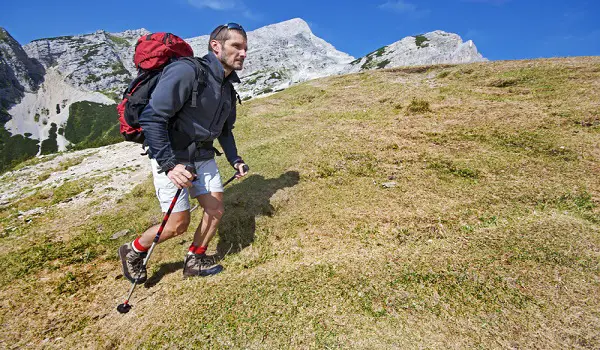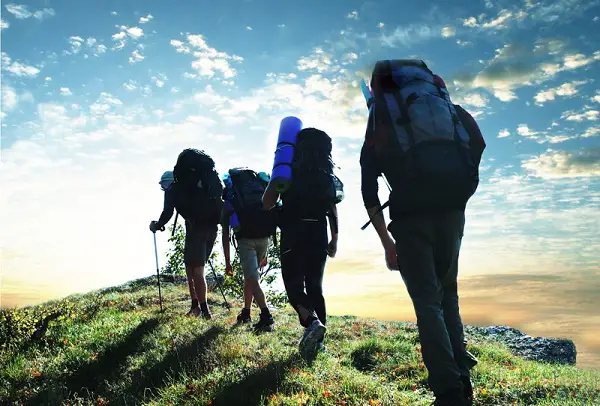If you’re new to hiking, knowing how to pace yourself on the trail may not be something you’re familiar with. The temptation when you first start out is to give everything you’ve got when you go out on the hills. While it can be tempting, you need to be careful that you don’t burn yourself out too soon.
Remember, however far you go, you need to get yourself back to where you’re started. If you burn yourself out on the outward journey, you might have difficulty getting back to base, definitely something you don’t want to do.
Keep a Steady Continuous Pace
Keeping a consistent pace is desirable. What I mean by that is that even when you come to harder uphill terrain, ideally you don’t slow your pace too much from walking on easier flatter terrain. The goal should be to keep your pace as steady as you can, within reason, regardless of the terrain.

The old classic rule, not sure where I picked this up, rings true here:
If you can keep a conversation going comfortably while you’re hiking uphill or over difficult terrain, you’re at a good pace.
Take Regular Breaks
Part of pacing yourself involves giving yourself adequate rest breaks. Generally speaking, on a day hike I recommend a 3 to 5 minute break every 1 or 2 hours and maybe a longer break for lunch, anywhere up to half an hour. This of course varies significantly depending on the skill, experience and fitness of the group hiking.
Now, this recommendation is heavily dependent on the weather. If it’s very wet or cold, stopping too often may not be advisable and it would be better to keep going to keep your body warm.
Remember, even if you feel very warm from exertion, you will cool down very quickly when you stop for a break on the trail in cold weather and you’re usually exposed to higher winds in the mountains. Always keep that in mind. Taking all that into consideration, stopping for a few minutes every 2 hours might serve you better.
Keep Your Muscles Moving
It’s obviously very important to keep your muscles moving when you’re hiking. If I stop for too long a stretch too often, I find my muscles can stiffen up a bit so when I stop I tend to stay standing on my feet and not stop for longer than the aforementioned 5 minutes. Any longer and I find my muscles start to tighten up a bit and it can be harder to get them moving again.
The exception to this is lunch. I usually like to pull up a pew on a stone or bush and sit down for that longer break. Again though, this is highly weather dependent. sitting down for lunch in torrential rain ain’t pleasant, soggy sandwiches and all that. So again, common sense prevails and where the situation requires it, I keep on moving. You can lunch on the trot 🙂
Deciding a Pace For a Group
As a general rule, you should aim to go at a steady pace that the slowest hiker in the group is comfortable with. Now, I think you can up the pace a little when you’re on reasonable terrain, after all, people want to get fitter so giving some opportunity for people to push themselves a little bit on a hike is fine in my book. However, this would only be for certain periods where it makes sense to do so.

This touches on another point that ideally, when hiking in a group, everyone on the hike should be of a relatively similar level of fitness so they’re not stretched too much. Similarly, the faster hikers in the group are not held back at too slow a pace for them.
This is why joining a hiking club can be such a good thing for a novice hiker. Normally, different grades of difficulty on hikes will be available. Therefore, you can start at a level that best suits your fitness level with a group of hikers at the same level.
Conclusion
Pacing yourself simply makes sense. It ensures you can enjoy your hike to the maximum while pushing yourself only to a comfortable level. Doing too much too soon can never be a good thing and at best will leave you with tired and aching bones for a few days after your hike and, at worst, a trip back to base courtesy of the local emergency rescue services! You definitely do not want the latter due to something as preventable as not pacing yourself 😉
When you start out, start small. Get a feel for what you are comfortable with. Try different terrains and see how you get on and slowly build it up. You will build your fitness up in no time. Also, it’s worth mentioning, I know plenty of hikers who never want to push themselves any further than a certain level. That is absolutely fine and makes good sense. When you find your level, you don’t need to push yourself any harder than that and you can choose to only take on hikes at that level in the future.
Have you any tips for pacing yourself or a group while out on the trail? I’d love to hear about it in the comments below.